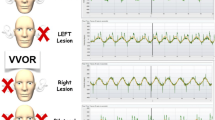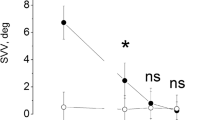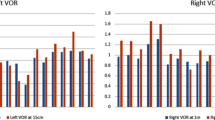Abstract
Ten normal subjects and nine patients with peripheral labyrinthine lesions were subjected to sinusoidal rotation about an earth-horizontal (EHA) and earth-vertical axis (EVA) using a new device. In normal subjects the gain of the vestibulo-ocular reflex (VOR) in EHA rotation was significantly larger than that of the VOR in EVA rotation. This difference may be attributed to the interaction of the semicircular canals and otolithic organs. Unlike normal subjects, patients with unilateral lesions showed no differences in gain between EHA and EVA rotations toward either the intact or abnormal side. Patients with bilateral lesions also showed no differences in gain. These observations suggest that the interaction of the semicircular canals with the otolithic organs enhancing VOR gain does not occur if one of the otolithic organs is defective in either ear. This does not appear to recover once such a dysfunction develops.
Similar content being viewed by others
References
Baloh RW, Beykirch K, Honrubia V, Yee RD (1988) Eye movements induced by linear acceleration on a parallel swing. J Neurophysiol 60:2000–2013
Barmack NH (1981) A comparison of the horizontal and vertical vestibulo-ocular reflexes of the rabbit. J Physiol (Lond) 314:547–564
Barmack NH (1987) The influence of gravity on horizontal and vertical vestibulo-ocular and optokinetic reflexes in the rabbit. Brain Res 424:89–98.
Benson AJ (1970) Interactions between semicircular canals and gravireceptors. In: Busby DE (eds). Recent advances in aerospace medicine. Reidel, Dordrecht, pp 249–261
Benson AJ, Bodin MA (1966) Interaction of linear and angular accelerations on vestibular receptors in man. Aerosp Med 37: 144–154
Diamond SG, Markham CH (1983) Ocular counterrolling as an indicator of vestibular otolith function Neurology 33:1460–1469
Goldberg JM, Fernàndez C (1982) Eye movements and vestibular nerve responses produced in the squirrel monkey by rotations about an earth-horizontal axis. Exp Brain 46:393–402
Guedry FE Jr (1965) Orientation of the rotation axis relative to gravity: its influence on nystagmus and the sensation of rotation. Acta Otolaryngol 60:30–48
Nogami K, Uemura T, Iwamoto M, Matsuoka K (1984) An algorithm for detecting the quick phases of nystagmus. Pract Otol Kyoto 77:2309–2315
Raphan T, Cohen B (1981) Effects of gravity on rotatory nystagmus in monkeys. Ann N Y Acad Sci 374:44–55
Takahashi M, Uemura T, Fujishiro T (1984) Recovery of vestibulo-ocular reflex and gaze disturbance in patients with unilateral loss of labyrinthine function. Ann Otol Rhinol Laryngol 93:170–175
Author information
Authors and Affiliations
Rights and permissions
About this article
Cite this article
Iwamoto, M., Uemura, T. & Nogami, K. Comparison of vestibulo-ocular reflexes in earth-horizontal and earth-vertical axis rotations. Eur Arch Otorhinolaryngol 251 (Suppl 1), S7–S11 (1994). https://doi.org/10.1007/BF02565211
Received:
Issue Date:
DOI: https://doi.org/10.1007/BF02565211




